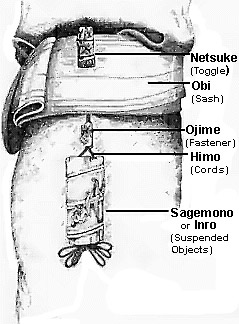 |
| © Janel Jacobson All Rights Reserved |
What is a Netsuke?
A netsuke is a form of miniature sculpture which developed in Japan over a period of more than three hundred years. Netsuke served both functional and aesthetic purposes. The kimono, the traditional form of Japanese dress, had no pockets. Women would tuck small personal items into their sleeves, but men suspended their tobacco pouches, pipes, purses, or writing implements on a silk cord from their obi (kimono sash). These hanging objects are called sagemono. To stop the cord from slipping through the obi, a small toggle was attached. The toggle is called a netsuke. (The most popular pronunciation is "net-ski", while the actual Japanese is closer to "netskeh"). A sliding bead (ojime) was strung on the cord between the netsuke and the sagemono to tighten or loosen the opening of the sagemono.
The entire ensemble was then worn, at the waist, and functioned as a sort of removable hip pocket. All three objects (the netsuke, the ojime and the different types of sagemono) were often beautifully decorated with elaborate carving, lacquer work, or inlays of rare and exotic materials, including: wood, ivory, precious metals, shell, coral, and semi-precious stones. All three items developed into highly coveted and collectible art forms.
